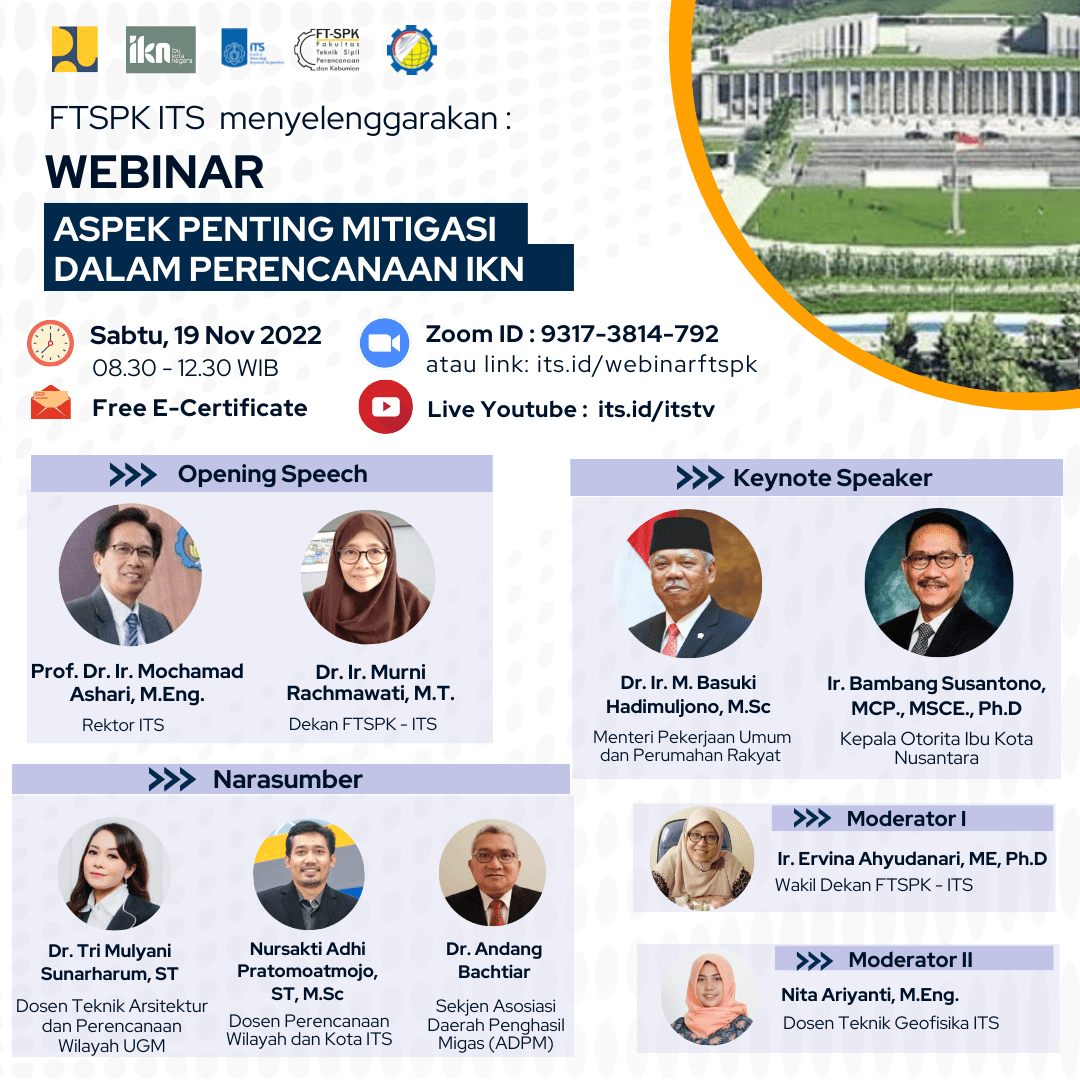FTSPK ITS Presents: WEBINAR ASPEK PENTING MITIGASI DALAM PERENCANAAN IBU KOTA NEGARA IKN)
Informasi

Law of the Republic of Indonesia Number 3 of 2022 concerning the State Capital (IKN) states that the State Capital named Nusantara and hereinafter referred to as the Archipelago Capital is a regional government unit that is special at the provincial level whose territory is the domicile of the State Capital as stipulated and governed by this Law. The IKN is located in Samboja District and Sepaku District, North Penajam Paser Regency, East Kalimantan. The location of the IKN is at the midpoint of the Indonesian archipelago which embodies changes in Indonesian civilization by presenting the concept of Indonesia-centric development for the sake of economic justice, for 17 thousand islands both development equality and development equity. The Capital City of the Archipelago has a vision of being a world city for all that is built and managed with the aim of becoming a sustainable city in the world, as a driving force for the Indonesian economy in the future; and become a symbol of national identity that represents the diversity of the Indonesian nation. President Jokowi has mandated the importance of the Indonesian Capital City Authority to become a city that does not only focus on its physical development, but also promotes cohesiveness with its citizens.
The territory of Indonesia is part of the Ring of Fire and is located in a tropical climate area and is flanked by 2 large oceans. This means that we live in a geological and hydrometeorological disaster area. Climate change that has occurred in recent years has increased hydrometeorological threats. According to the World Risk Report 2021, Indonesia is in 38th place out of 181 countries at risk of disasters. The National Disaster Management Agency (BNPB) noted that in 2021 there were 5,402 disasters. In fact, as of October 20, 2022, the number of disasters that have occurred is 2,888. At the 7th Global Platform for Disaster Risk Reduction (GPDRR) meeting in June 2022, Indonesia had the opportunity to submit recommendations for the Bali Agenda for Sustainable Resilience.
The first recommendation, disaster risk reduction needs to be integrated into key development and financing policies, legislation, and plans to achieve the 2030 Agenda. Risk governance mechanisms are immediately transformed to ensure that risk management is a shared responsibility across sectors, systems, scales, and boundaries. To answer this, Law Number 3 of 2022 concerning IKN Part Four Disaster Management Article 19 states that the implementation of disaster management in the Archipelago Capital City is carried out by the Archipelago Capital City Authority with reference to the Archipelago Capital City Master Plan and the Archipelago Capital KSN Spatial Plan.
In line with ITS Mission to contribute in science and technology for the welfare of society through education, research, community service and management activities based on information and communication technology. For this reason, the Faculty of Civil and Earth Planning Engineering (FTSPK) Sepuluh Nopember Institute of Technology Surabaya will hold a NATIONAL WEBINAR “Important Aspects of Disaster Mitigation and Planning of the National Science Institute”. This webinar aims to find out the progress of planning and development of IKN related to disaster. It is hoped that all parties, especially ITS, can actively participate in the planning and development of IKN.
The webinar will be held on:
- Day/Date : Saturday, 19 Nov 2022
- Time : 08.30 – 12.30
- Link Meeting : https://its-ac-id.zoom.us/j/93173814792?pwd=Y1IwT3NqaHZsSFRwYXd3d0VaeVhOdz09
- Meeting ID: 9317-3814-792
The source material will be updated in the following links:
- Dr. Ir. M. Basuki Hadimuljono, M.Sc (Menteri Pekerjaan Umum dan Perumahan Rakyat)
- Ir. Bambang Susantono, MCP., MSCE., Ph.D (Kepala Otorita Ibu Kota Nusantara)
- Dr. Tri Mulyani Sunarharum, ST (Dosen Teknik Arsitektur dan Perencanaan Wilayah UGM)
- Nursakti Adhi Pratomoatmojo, ST, M.Sc (Dosen Perencanaan Wilayah dan Kota ITS)
- Dr. Andang Bachtiar (Sekjen Asosiasi Daerah Penghasil Migas)
Latest News
-
Pertemuan Ortu Maba 2025 Departemen Teknik Geofisika ITS
Departemen Teknik Geofisika ITS telah menyelenggarakan pertemuan bersama dengan orang tua mahasiswa baru 2025. Pertemuan ini merupakan sesi kedua
-
WEBINAR PERENCANAAN TATA RUANG BERKELANJUTAN BERBASIS RISIKO BENCANA
Kejadian gempa, tsunami, likuifaksi, letusan gunung api, longsor, hujan, banjir, banjir bandang, angin, panas kemarau diikuti karhutla dan kekeringan,
-
Teknik Geofisika ITS Ajak Mahasiswa Asing Menyelami Teknologi Pengukuran Geofisika
Teknik Geofisika ITS kembali kedatangan tamu asing untuk berbagi seputar kegiatan laboratorium Geofisika dalam rangkaian acara Commtech Highlight. “Innovation





